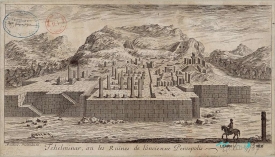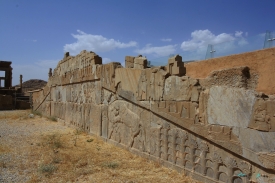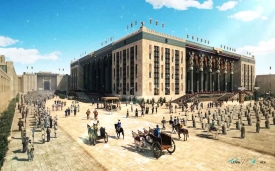ABOUT Persepolis
Persepolis, known in Old Persian as Parsa and today as Takht-e Jamshid ("Throne of Jamshid"), was the awe-inspiring ceremonial capital of the Achaemenid Empire. Located in the Fars province, about 75 km northeast of Shiraz in Iran, this city is an exceptional testament to the grandeur and sophistication of one of antiquity's most influential civilizations.
Darius I's successors continued to embellish and expand Persepolis. Xerxes I added iconic structures such as the Gate of All Nations and the Hall of One Hundred Columns. Building efforts continued for over two centuries, establishing Persepolis as a crucial administrative and political center for governing the empire.
The city featured a monumental terrace housing various palaces for ceremonial and administrative purposes. Highlights include the Apadana, or audience hall, and the Tachara, the private palace of Darius I. The structures were adorned with elaborate reliefs and sculptures depicting the empire's diverse peoples, symbolizing the king's authority.
The reliefs of Persepolis are celebrated for their detailed craftsmanship and symbolism. They depict processions of dignitaries and delegations from different regions, royal audience scenes, and mythological figures. These works showcase not only artistic skill but also the cultural diversity of the empire.
These tablets, primarily written in Elamite between 506 and 497 BC during the reign of Darius I, contain administrative texts offering invaluable insights into the empire's operations and governance. They include details on material transportation, accounting records, construction, communication, and finances. They also provide glimpses into daily life in Persepolis, revealing the names and roles of individuals from laborers to the treasurer. Some tablets even shed light on the different statuses of women in Achaemenid society.
Persepolis is more than an ancient ruined city; it is an enduring symbol of the Persian Empire's grandeur and its influence on human history. Its architecture and art reflect a unique convergence of cultures and styles, and its legacy continues to inspire scholars and visitors worldwide.
History and Foundation of Persepolis
The construction of Persepolis began in 521 BC under the rule of King Darius I. Conceived as a symbol of unity and diversity within the vast Persian Empire, the city was designed to reflect the legitimate and absolute power of the monarch. Artisans and workers from all regions of the empire participated in its construction, integrating a variety of architectural and artistic styles that culminated in a unique Persian aesthetic.Darius I's successors continued to embellish and expand Persepolis. Xerxes I added iconic structures such as the Gate of All Nations and the Hall of One Hundred Columns. Building efforts continued for over two centuries, establishing Persepolis as a crucial administrative and political center for governing the empire.
Destruction by Alexander the Great
In 331 BC, Alexander the Great conquered Persepolis. According to historical accounts, the city was set ablaze in 330 BC, possibly as an act of revenge for Persian invasions of Greece. This fire marked the decline of the Achaemenid Empire, leaving Persepolis in ruins. Though destroyed, its legacy endured across centuries, serving as a symbol of the fall of one empire and the rise of another.Architecture and Art: A Lasting Legacy
The architecture of Persepolis is a fusion of styles from various cultures under Persian rule, including Mesopotamian, Egyptian, and Greek influences. This amalgamation created a distinct Persian architectural style, notable for its hypostyle halls and slender columns.The city featured a monumental terrace housing various palaces for ceremonial and administrative purposes. Highlights include the Apadana, or audience hall, and the Tachara, the private palace of Darius I. The structures were adorned with elaborate reliefs and sculptures depicting the empire's diverse peoples, symbolizing the king's authority.
The reliefs of Persepolis are celebrated for their detailed craftsmanship and symbolism. They depict processions of dignitaries and delegations from different regions, royal audience scenes, and mythological figures. These works showcase not only artistic skill but also the cultural diversity of the empire.
Discovery of the Cuneiform Tablets
During archaeological excavations led by Ernst Herzfeld and Erich Friedrich Schmidt, two archives were discovered, containing numerous wooden and clay cuneiform tablets in Persepolis. The first series, known as the "Fortification Tablets of Persepolis", was found in the fortification area on the northeast corner of the terrace. It consists of around 30,000 pieces, of which 6,000 are legible. While 5,000 of these have been studied, they have yet to be fully published.These tablets, primarily written in Elamite between 506 and 497 BC during the reign of Darius I, contain administrative texts offering invaluable insights into the empire's operations and governance. They include details on material transportation, accounting records, construction, communication, and finances. They also provide glimpses into daily life in Persepolis, revealing the names and roles of individuals from laborers to the treasurer. Some tablets even shed light on the different statuses of women in Achaemenid society.
Persepolis is more than an ancient ruined city; it is an enduring symbol of the Persian Empire's grandeur and its influence on human history. Its architecture and art reflect a unique convergence of cultures and styles, and its legacy continues to inspire scholars and visitors worldwide.
The Best Pictures of Persepolis
Videos of Persepolis























